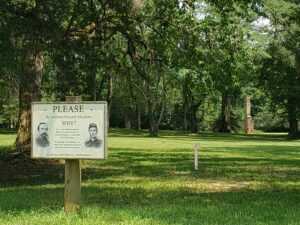by Bryan & Heather
America is no stranger to ghost towns. Indeed, they are in some strange way a key element of Americana, whether as remnants of a mythologized Old West or, more recently, as testament to the plight of the Rust Belt and blue collar America more generally in a rapidly globalizing world. Over Fourth of July weekend 2023, we decided to visit one of these ghost towns that happened to be fairly close to us, located just outside the modern city of Selma: Alabama’s first state capital of Cahawba.

When Bryan first read of Alabama’s early territorial and state history, we knew we eventually had to make it to this old town situated at the confluence of the Cahaba and Alabama rivers. Conceived by the state’s first governor, William Bibb, Cahawba was a brand new town not unlike the new nation’s capital of Washington; centrally located, planned out of whole cloth on bottomland that would prove just as much of a hazard as a transportational benefit. While it only served as capital for five years (1820-1825) due to its seasonal flooding and malarial conditions, Cahawba nevertheless developed into a thriving Black Belt settlement, retaining the seat of one of the nation’s wealthiest antebellum counties. While the town’s leading citizens had ensured its relevance through construction of a railroad spur line in the 1850s, the outbreak of the Civil War brought hard times and, ultimately, ruin as that railroad was appropriated by the Confederate government, disassembled, and used to construct more strategically-placed infrastructure. Deprived of all economic and political relevance by the twin blows of emancipation and the county seat being moved to nearby Selma in 1866, Cahawba rapidly declined until, by the turn of the century, it was largely abandoned.

Unlike all those hauntingly preserved Western ghost towns, however, you would be hard pressed to realize that Cahaba has ever been anything but thickets of new growth forest and scattered small farms if it wasn’t for the Alabama Historical Commission’s archeological park. The town’s buildings were scavenged for construction materials in the early twentieth century, and the lush southeastern undergrowth has since reclaimed the rest, leaving only depressions, gullies, and overgrown gravestones where once flourished a state capital. Old Cahawba Archaeological Park is thus faced with the problem of interpreting history and power of place in the apparent absence of both. This it does admirably, for the most part; the old Alabama state house is reconstructed using a unique silhouette method that gives visitors a sense of the building’s scale while being presumably more cost-effective than a full restoration, and each of the town’s three cemeteries (including an old slave cemetery) have their own walking tours that shed light on the people who once lived–and died–there.

That said, there are regrettably no photographs of the entire town as it was in its heyday to compare with the modern wilderness, and the on-site interpretation of Cahawba’s Civil War prisoner of war camp, Castle Morgan, is curiously light, especially considering that its former inmates were the only soldiers not from Andersonville involved in the Sultana steamboat disaster (though the Visitors’ Center has a great binder with all known information for each soldier held there). It’s also unfortunate that, unless you’re taking advantage of the park’s canoe put-in, neither the Cahaba nor the Alabama is visible any longer through the dense underbrush, at least in the summer.

We’ll take a mixed bag, though, when it comes to a park that we weren’t ever sure would have interpretation beyond the Visitors’ Center when we first started planning our trip. For the discerning visitor, Cahawba can serve as anything from a historical romp through nature (bikes are available along with the canoes, and trails abound), an obscure Civil War pilgrimage, a reminder that America’s original frontier and boom towns lay quite close to the metropolises of the East Coast, or even cause to reflect on just how fleeting our human civilization can be. Whichever might appeal to you, it’s well worth the visit.
